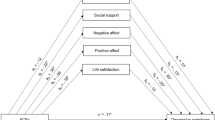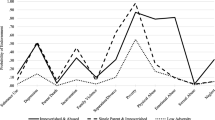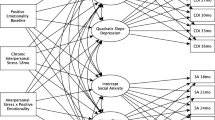Abstract
Negative life events (NLEs) are associated with psychopathology in older adolescents and adults, particularly for women. However, less is known about the association between positive life events (PLEs) and psychopathology. This study examined associations between NLEs, PLEs, and their interaction, and sex differences in associations between PLEs and NLEs on internalizing and externalizing psychopathology. Youth completed interviews about NLEs and PLEs. Parents and youth reported on youth internalizing and externalizing symptoms. NLEs were positively associated with youth-reported depression and anxiety and parent-reported youth depression. Female youth had stronger positive associations between NLEs and youth-reported anxiety than male youth. Interactions between PLEs and NLEs were non-significant. Findings for NLEs and psychopathology are extended to earlier in development.

Similar content being viewed by others
References
Richardson CME (2017) Emotion regulation in the context of daily stress: impact on Daily Affect. Personal Individ Differ 112:150–156
Baddam SKR, Olvera RL, Canapari CA, Crowley MJ, Williamson DE (2019) Childhood Trauma and Stressful Life events are independently Associated with Sleep Disturbances in adolescents. Behav Sci 9(10):108
McMahon G, Creaven AM, Gallagher S (2020) Stressful life events and adolescent Well-Being: the role of parent and peer Relationships. Stress Health J Int Soc Investig Stress 36(3):299–310
Anda RF, Felitti VJ, Bremner JD, Walker JD, Whitfield Ch, Perry BD et al (2006) The Enduring Effects of abuse and related adverse Experiences in Childhood. Eur Arch Psychiatry Clin Neurosci 256(3):174–186
Dupéré V, Dion E, Leventhal T, Archambault I, Crosnoe R, Janosz M (2018) High School Dropout in Proximal Context: the triggering role of Stressful Life events. Child Dev 89(2):e107–e122
Mann MJ, Kristjansson AL, Smith ML, Sigfusdottir ID (2016) The influence of negative life events and Problem Behavior on Grades in early adolescence: pathways to academic risk in the Middle Grades. RMLE Online 39(10):1–13
Roberts YH, English D, Thompson R, White CR (2018) The impact of Childhood Stressful Life events on Health and Behavior in a risk youth. Child Youth Serv Rev 85:117–126
Armstrong JL, Ronzitti S, Hoff RA, Potenza MN (2018) Gender moderates the relationship between Stressful Life events and psychopathology: findings from a National Study. J Psychiatr Res 107:34–41
Ge X, Conger RD, Elder GH (2001) Pubertal Transition, Stressful Life events, and the emergence of gender differences in adolescent depressive symptoms. Dev Psychol 37(3):404–417
Kucharska J (2017) Sex differences in the Appraisal of traumatic events and psychopathology. Psychol Trauma Theory Res Pract Policy 9(5):575–582
Eisenbarth H, Godinez D, du Pont A, Corley RP, Stallings MC, Rhee SH (2019) The influence of Stressful Life events, psychopathy, and their Interaction on Internalizing and Externalizing psychopathology. Psychiatry Res 272:438–446
Felton JW, Collado A, Havewala M, Shadur JM, MacPherson L, Lejuez CW (2019) Distress tolerance interacts with negative life events to predict depressive symptoms across adolescence. J Clin Child Adolesc Psychol 48(4):633–642
Ginsburg GS, Becker-Haimes EM, Keeton C, Kendall PC, Iyengar S, Sakolsky D et al (2018) Results from the Child/Adolescent anxiety Multimodal Extended Long-Term Study (CAMELS): primary anxiety outcomes. J Am Acad Child Adolesc Psychiatry 57(7):471–480
Blonski SC, Conradi HJ, Oldehinkel AJ, Bos EH, de Jonge P (2016) Associations between negative and positive life events and the Course of Depression: a detailed repeated-assessments study. J Nerv Ment Dis 204(3):175–180
Dixon WA, Reid JK (2000) Positive life events as a moderator of stress-related depressive symptoms. J Couns Dev 78(3):343–347
Doyle KW, Wolchik SA, Dawson-McClure SR, Sandler IN (2003) Positive events as a stress buffer for children and adolescents in families in transition. J Clin Child Adolesc Psychol 32(4):536–545
Kendler KS, Hettema JM, Butera F, Gardner CO, Prescott CA (2003) Life event dimensions of loss, humiliation, Entrapment, and Danger in the prediction of onsets of Major Depression and generalized anxiety. Arch Gen Psychiatry 60(8):789–796
McLaughlin KA, Conron KJ, Koenen KC, Gilman SE (2010) Childhood Adversity, Adult Stressful Life events, and risk of Past-Year Psychiatric disorder: a test of the stress sensitization hypothesis in a Population-based sample of adults. Psychol Med 40(10):1647–1658
Kendler KS, Karkowski LM, Prescott CA (1999) Causal relationship between Stressful Life events and the Onset of Major Depression. Am J Psychiatry 156(6):837–841
Michl LC, McLaughlin KA, Shepherd K, Nolen-Hoeksema S (2013) Rumination as a mechanism linking Stressful Life events to symptoms of depression and anxiety: longitudinal evidence in early adolescents and adults. J Abnorm Psychol 122(2):339–352
Silberg J, Rutter M, Neale M, Eaves L (2001) Genetic moderation of environmental risk for depression and anxiety in adolescent girls. Br J Psychiatry 179(2):116–121
Allen JL, Rapee RM (2009) Are reported differences in life events for anxious children and controls due to Comorbid Disorders? J Anxiety Disord 23(4):511–518
Brown S, Fite PJ, Poquiz J (2016) Moderating Effects of gender on Outcomes Associated with Stressful Life events among Elementary School-Age Youth. Child Psychiatry Hum Dev 47(4):593–602
Phillips NK, Hammen CL, Brennan PA, Najman JM, Bor W (2005) Early Adversity and the prospective prediction of depressive and anxiety Disorders in adolescents. J Abnorm Child Psychol 33(1):13–24
Flouri E, Kallis C (2011) Adverse life events and Mental Health in Middle Adolescence. J Adolesc 34(2):371–377
Yıldız M (2020) Stressful life events and adolescent suicidality: an investigation of the Mediating Mechanisms. J Adolesc 82:32–40
Hankin BL, Mermelstein R, Roesch L (2007) Sex differences in adolescent depression: stress exposure and reactivity models. Child Dev 78(1):279–295
Slopen N, Williams DR, Fitzmaurice GM, Gilman SE (2011) Sex, Stressful Life events, and adult Onset Depression and Alcohol Dependence: are men and women equally vulnerable? Soc Sci Med 73(4):615–622
Grover RL, Ginsburg GS, Ialongo N (2005) Childhood predictors of anxiety symptoms: a longitudinal study. Child Psychiatry Hum Dev 36(2):133–153
Gauthier-Duchesne A, Hébert M, Daspe M (2017) Gender as a predictor of posttraumatic stress symptoms and externalizing behavior problems in sexually abused children. Child Abuse Negl 64:79–88
Spinhoven P, Elzinga BM, Hovens JGFM, Roelofs K, van Oppen P, Zitman FG et al (2011) Positive and negative life events and personality traits in Predicting Course of Depression and anxiety. Acta Psychiatr Scand 124(6):462–473
Beevers CG, Meyer B (2002) Lack of positive experiences and positive expectancies mediate the relationship between BAS responsiveness and depression. Cogn Emot 16(4):549–564
Khazanov GK, Ruscio AM, Swendsen J (2019) The “Brightening” Effect: reactions to positive events in the Daily lives of individuals with major depressive disorder and generalized anxiety disorder. Behav Ther 50(2):270–284
Doorley JD, Goodman FR, Disabato DJ, Kashdan TB, Weinstein JS, Shackman AJ (2021) The momentary benefits of positive events for individuals with elevated social anxiety. Emotion 21(3):595–606
Reich JW, Zautra A (1981) Life events and personal causation: some Relationships with satisfaction and distress. J Pers Soc Psychol 41(5):1002–1012
Dohrenwend BP (2006) Inventorying stressful life events as risk factors for psychopathology: toward resolution of the Problem of Intracategory Variability. Psychol Bull 132(3):477–495
Hammen C (2018) Risk factors for Depression: an autobiographical review. Annu Rev Clin Psychol 14(1):1–28
Harkness KL, Monroe SM (2016) The Assessment and Measurement of adult life stress: Basic Premises, operational principles, and design requirements. J Abnorm Psychol 125(5):727–745
Vrshek-Schallhorn S, Mineka S, Zinbarg RE, Craske MG, Griffith JW, Sutton J et al (2014) Refining the candidate environment: interpersonal stress, the Serotonin Transporter Polymorphism, and gene-environment interactions in Major Depression. Clin Psychol Sci 2(3):235–248
Achenbach TM, McConaughy SH, Howell CT (1987) Child/Adolescent behavioral and emotional problems: implications of cross-informant correlations for situational specificity. Psychol Bull 101(2):213–232
van de Looij-Jansen PM, Jansen W, de Wilde EJ, Donker MCH, Verhulst FC (2011) Discrepancies between parent-child reports of internalizing problems among preadolescent children: Relationships with gender, ethnic background, and future internalizing problems. J Early Adolesc 31(3):443–462
Kaufman AS (1990) Kaufman brief intelligence test: KBIT. AGS, American Guidance Service Circle Pines, MN
Safford SM, Alloy LB, Abramson LY, Crossfield AG (2007) Negative cognitive style as a predictor of negative life events in Depression Prone individuals: a test of the stress generation hypothesis. J Affect Disord 99(1):147–154
Hankin BL, Abramson LY (2002) Measuring cognitive vulnerability to Depression in Adolescence: reliability, validity, and gender differences. J Clin Child Adolesc Psychol 31(4):491–504
Kovacs M (2003) Children’s Depression Inventory
Bang YR, Park JH, Kim SH (2015) Cut-off Scores of the children’s Depression Inventory for Screening and Rating Severity in Korean Adolescents. Psychiatry Investig 12(1):23–28
Birmaher B, Brent DA, Chiappetta L, Bridge J, Monga S, Baugher M (1999) Psychometric Properties of the screen for child anxiety related Emotional Disorders (SCARED): a replication study. J Am Acad Child Adolesc Psychiatry 38(10):1230–1236
Canals J, Hernández-Martínez C, Cosi S, Domènech E (2012) Examination of a cutoff score for the screen for child anxiety related Emotional Disorders (SCARED) in a non-clinical Spanish Population. J Anxiety Disord 26(8):785–791
Achenbach TM (2001) Manual for ASEBA school-age forms & profiles. Univ Vt Res Cent Child Youth Fam
Achenbach TM, Edelbrock CS (1979) The child Behavior Profile: II. Boys aged 12–16 and girls aged 6–11 and 12–16. J Consult Clin Psychol 47(2):223
Youngstrom E, Loeber R, Stouthamer-Loeber M (2000) Patterns and correlates of agreement between parent, teacher, and male adolescent ratings of externalizing and internalizing problems. J Consult Clin Psychol 68(6):1038–1050
Hudziak JJ, Copeland W, Stanger C, Wadsworth M (2004) Screening for DSM-IV Externalizing Disorders with the child Behavior Checklist: a receiver-operating characteristic analysis. J Child Psychol Psychiatry 45(7):1299–1307
Ebesutani C, Bernstein A, Nakamura BJ, Chorpita BF, Higa-McMillan CK, Weisz JR et al (2010) Concurrent validity of the child Behavior Checklist DSM-Oriented Scales: correspondence with DSM Diagnoses and comparison to Syndrome Scales. J Psychopathol Behav Assess 32(3):373–384
Seligman LD, Ollendick TH, Langley AK, Baldacci HB (2004) The utility of measures of child and adolescent anxiety: a Meta-Analytic Review of the revised children’s manifest anxiety scale, the state–trait anxiety inventory for children, and the child Behavior Checklist. J Clin Child Adolesc Psychol 33(3):557–565
Aiken LS, West SG, Reno RR (1991) Multiple regression: testing and interpreting interactions. SAGE, p 228
Muthén LK, Muthén BO (1998) –2012 Mplus User’s Guide; Seventh Edition
Hallquist MN, Wiley JF (2018) MplusAutomation: an R Package for Facilitating large-scale latent variable analyses in Mplus. Struct Equ Model Multidiscip J 25(4):621–638
Asselmann E, Wittchen HU, Lieb R, Höfler M, Beesdo-Baum K (2015) Danger and loss events and the incidence of anxiety and depressive Disorders: a prospective-longitudinal community study of adolescents and young adults. Psychol Med 45(1):153–163
Braet C, Vlierberghe LV, Vandevivere E, Theuwis L, Bosmans G (2013) Depression in Early, Middle and late adolescence: Differential evidence for the cognitive diathesis–stress model. Clin Psychol Psychother 20(5):369–383
Choudhury MS, Pimentel SS, Kendall PC (2003) Childhood anxiety Disorders: parent–child (Dis) Agreement using a structured interview for the DSM-IV. J Am Acad Child Adolesc Psychiatry 42(8):957–964
Grills AE, Ollendick TH (2003) Multiple informant agreement and the anxiety Disorders interview schedule for parents and children. J Am Acad Child Adolesc Psychiatry 42(1):30–40
Rothen S, Vandeleur CL, Lustenberger Y, Jeanprêtre N, Ayer E, Gamma F et al (2009) Parent–child agreement and prevalence estimates of Diagnoses in Childhood: direct interview Versus Family History Method. Int J Methods Psychiatr Res 18(2):96–109
Salbach-Andrae H, Klinkowski N, Lenz K, Lehmkuhl U (2009) Agreement between Youth-Reported and parent-reported psychopathology in a referred sample. Eur Child Adolesc Psychiatry 18(3):136–143
Hankin BL, Abramson LY, Moffitt TE, Silva PA, McGee R, Angell KE (1998) Development of Depression from Preadolescence to Young Adulthood: emerging gender differences in a 10-Year longitudinal study. J Abnorm Psychol 107:128–140
Cougle JR, Timpano KR, Sachs-Ericsson N, Keough ME, Riccardi CJ (2010) Examining the Unique Relationships between anxiety Disorders and Childhood Physical and sexual abuse in the National Comorbidity Survey-Replication. Psychiatry Res 177(1):150–155
Francis JL, Moitra E, Dyck I, Keller MB (2012) The impact of Stressful Life events on relapse of generalized anxiety disorder. Depress Anxiety 29(5):386–391
Cohen LH, McGowan J, Fooskas S, Rose S (1984) Positive life events and social support and the relationship between life stress and psychological disorder. Am J Community Psychol 12(5):567–587
Shahar G, Priel B (2002) Positive life events and adolescent emotional distress: in search of protective-interactive processes. J Soc Clin Psychol 21(6):645–668
Brewin CR, Andrews B, Gotlib IH (1993) Psychopathology and early experience: a reappraisal of Retrospective Reports. Psychol Bull 113(1):82–98
Funding
This publication was supported by R01 MH107495 (Olino).
Author information
Authors and Affiliations
Contributions
SM conducted data analysis and drafted the manuscript under the supervision of TMO. TMO, LCS, SLB, and JDN provided critical revisions to the writing, analysis plan, and drafting of the manuscript.
Corresponding author
Ethics declarations
Competing Interests
The authors declare no competing interests.
Additional information
Publisher’s Note
Springer Nature remains neutral with regard to jurisdictional claims in published maps and institutional affiliations.
Electronic Supplementary Material
Below is the link to the electronic supplementary material.
Rights and permissions
Springer Nature or its licensor (e.g. a society or other partner) holds exclusive rights to this article under a publishing agreement with the author(s) or other rightsholder(s); author self-archiving of the accepted manuscript version of this article is solely governed by the terms of such publishing agreement and applicable law.
About this article
Cite this article
Madhavan, S., Stewart, L., Birk, S. et al. Positive and Negative Life Events in Association with Psychopathology: An Examination of Sex Differences in Early Adolescence. Child Psychiatry Hum Dev (2023). https://doi.org/10.1007/s10578-023-01509-w
Accepted:
Published:
DOI: https://doi.org/10.1007/s10578-023-01509-w




